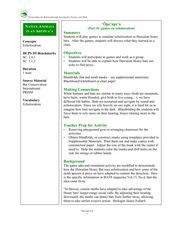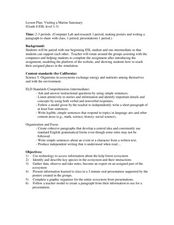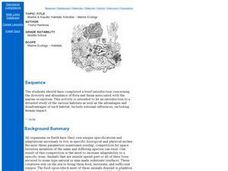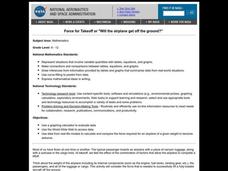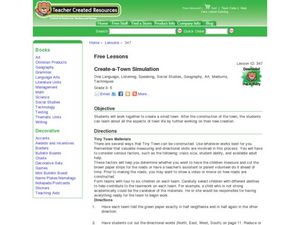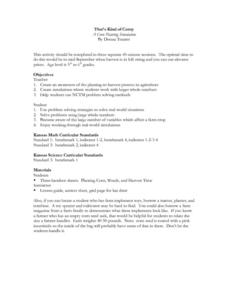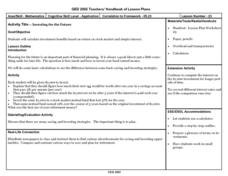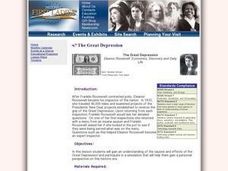Curated OER
Lotto or Life: What Are the Chances?
Though the website does not seem to have the mentioned video, a reding and lottery style games simulate the chances of finding intelligent life somewhere other than Earth. Without the video, this activity is short, but it can be a useful...
Curated OER
Games on Echolocation
Get a little batty with life science! This fun simulation game replicates how bats use echolocation to hunt moths in their native Hawaiian habitat. After creating blind folds and discussing some basic principles of echolocation, young...
Curated OER
Probability Experiment Simulation: Design and Data Analysis Using a Graphing Calculator
Seventh graders simulate probability experiments. Using a graphing calculator, 7th graders design, conduct, and draw conclusions from simulations or probability experiments. Students construct frequency tables and compare the...
Curated OER
Simulation and Accounting Practices
Students implement their knowledge about accounting practices into a simulation activity. For this secondary consumer/business math lesson, students participate in a simulation centered on the life of the people during the...
Curated OER
Teaching Radioactive Decay: Radioactive Half-life And Dating Techniques
Learners generate a radioactive decay table for an imaginary element using a box filled with pinto beans and M&M's. They use their data to plot a decay graph, develop the concept of half-life, and use the graph to "age" several samples.
Curated OER
Percents: (An Application to Real Life Problems)
Seventh graders explore the concept of calculating percents. In this calculating percents lesson, 7th graders simulate ordering food off of a menu. Students work in groups to calculate the bill, tax, and the tip for the...
Curated OER
Visiting a Marine Sanctuary
Learners gather information on a kelp forest and identify species in that ecosystem. In this underwater ecosystem lesson plan students gather data, give an oral presentation and create a poster.
Curated OER
An Organic Work That Imitates Life
Students practice using organic and geometric forms while creating individual works of art. This creative art lesson plan incorporates Math concepts for a cross-curricular approach in the classroom.
Curated OER
Marine & Aquatic Habitats Activities - Marine Ecology
Middle schoolers enact the life cycle of a sessile animal and quantify the possibility of survival under the conditions given. They then present to the class a new adaptation which will increase the animals chance of survival.
Curated OER
How Many?
Middle schoolers explore and design ways to collect data through simulations and random samples. They perform two experiments to determine the answers to various probability problems, and present the data/graphs in the form of a...
EngageNY
Making Fair Decisions
Life's not fair, but decisions can be. The 17th installment of a 21-part module teaches learners about fair decisions. They use simulations to develop strategies to make fair decisions.
Curated OER
Math: Will The Airplane Get Off the Ground?
Students use data from real-life models to calculate and compare the force required for an airplane of a given weight to become airborne. They use a graphing calculator to evaluate data and use the World Wide Web to access data.
Curated OER
Checkbook Math
Twelfth graders simulate balancing checkbooks by applying required mathematical operations. They examine newspaper ads from banks and compare various services they offer. They discuss the uses of credit and debit cards.
Curated OER
Money Math
Students explore the use of money in daily life. Through activities and real-life simulations, students write and balance a checkbook, explore the importance of budgeting, saving, and expenses. Using spreadsheet technology, they examine...
Curated OER
It's Your Life
Students make a multiple line graph showing income levels for each education level for the past 8 years and the number of people for each ethnic group and gender is compared within each education level.
Curated OER
Create-A-Town Simulation
Students design and construct a model town. In this community lesson, students will collaboratively build a small town from construction paper and toys.
Prince William Network
The Incredible Journey
Divide your school gym into breeding grounds and non-breeding grounds so that your zoologists can play a game simulating the seasonal migration of shorebirds. Players pick one of the included game cards and follow its directions, which...
Curated OER
That's Kind of Corny!
Students apply math skills to determining how much corn seed to plant in 100 acres. They compute the amount of weed killer needed and after totaling how many bushels per acre they harvest, they calculate their profits.
Curated OER
Investing for the Future
Twelfth graders perform basic calculations for saving and investment strategies. they simulate the investment of $1,000 in the stock market and savings account. they determine which pays the greater dividend.
Curated OER
Westward Expansion
Students locate California and New York on a map and explore available means of travel in the 19th century. Students explore the role of trade in pioneer America and simulate various barter transactions.
Curated OER
Blubber Gloves
The ways that animals adapt to their environments is quite remarkable. In this life science lesson, fifth graders take a look at some of the ways that aquatic animals that live in Arctic or Antarctic waters survive. They perform an...
Curated OER
Investigation - Snack TIme
Students explore solving addition and subtraction problems. They solve real life problems. Students participate in a simulation activity to find the missing addend. They demonstrate adding and subtracting whole numbers.
National First Ladies' Library
Eleanor Roosevelt: Economics, Discovery and Daily Life
Examine the causes and effects of the Great Depression and the role of Eleanor Roosevelt during the era. Pupils take an inventory of their home for wants and needs, and conduct online research on The Great Depression. They then convert...
Teach Engineering
Processes on Complex Networks
Introduces your class to random processes in networks with an activity that uses information about disease spread using the susceptible, infectious, resistant (SIR) model. Participants determine whether a susceptible person becomes...



